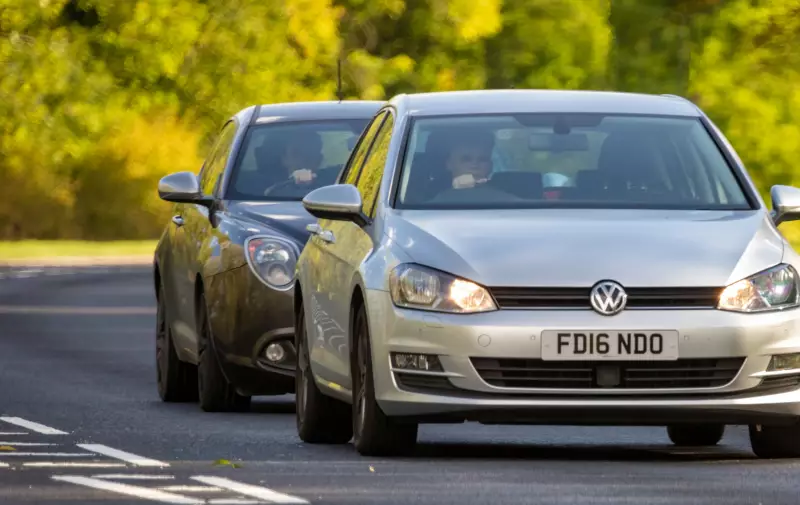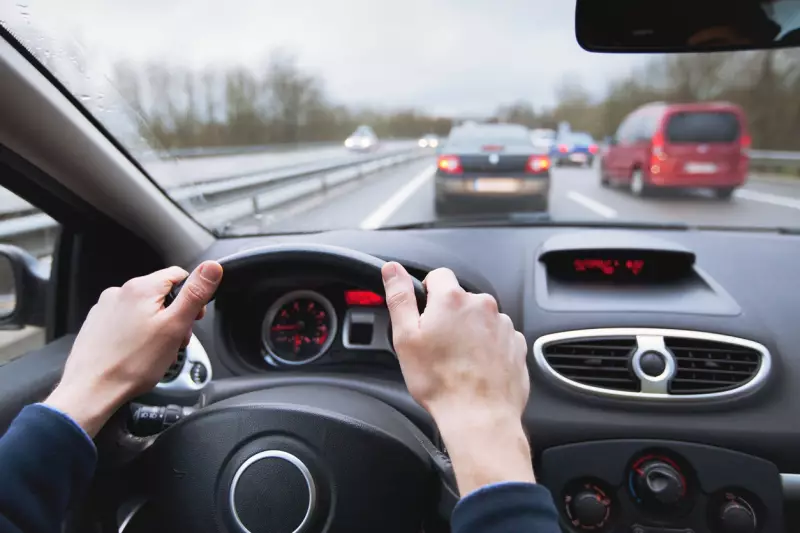A tailgating car is more than just an annoyance—it puts everyone on the road at risk.
When a vehicle follows too closely behind another, it has little time to react if the car ahead suddenly stops, leading to potential crashes.
Whether someone has been the victim of tailgating or has found themselves following another car too closely, many drivers underestimate this behavior.
Understanding car tailgating, its psychology, the proper following distance, and the associated dangers can significantly enhance safety for all road users. Knowing how to handle a tailgater and the legal penalties for this reckless behavior can help drivers navigate these situations responsibly and avoid accidents.
What Is Tailgating in Driving?
In driving, car tailgating refers to following another vehicle too closely without leaving enough space for safe braking. It occurs when a driver positions their car right behind the one in front, often neglecting the need for a safe distance.
Tailgating in driving commonly occurs in heavy traffic, where motorists may feel pressured to keep up. It can also happen on highways, where vehicles travel at higher speeds. In these situations, tailgaters might think that staying close to the car ahead will help them navigate traffic more easily. However, this behavior is both aggressive and risky.
There are several reasons why a tailgating car is dangerous:
- Following too closely decreases the time available to react if the vehicle in front suddenly stops or slows down.
- A tailgating car raises the likelihood of rear-end crashes, which can result in serious injuries or fatalities.
- Drivers who tailgate may be more prone to distractions as they are focused on the vehicle ahead rather than the road.
- Close proximity to the vehicle in front can make maneuvering difficult.
- Car tailgating can lead to aggressive driving behaviors and road rage incidents.
- Tailgating contributes to congestion and can create stop-and-go traffic.
Why Do People Tailgate?
Tailgating in driving often arises from a combination of psychological and situational factors.
Drivers Are in a Rush
Many drivers are in a hurry, especially during rush hour or heavy traffic, which leads to impatience and frustration. In these situations, they may tailgate to express dissatisfaction with slower vehicles in the hopes of pushing them to speed up.
Drivers Are Distracted
With numerous distractions on the road, some drivers might not realize how closely they are following the car in front of them.
Drivers Are Impatient
Sometimes, a tailgating car can be a sign of road rage. Drivers overwhelmed by stress or irritation—perhaps due to hitting multiple red lights or facing unexpected delays—might take out their frustrations by tailgating. Doing so not only escalates tensions but also creates a hostile driving environment.
Drivers Miscommunicate
Some individuals may view car tailgating as a way to assert dominance or reprimand slower drivers. They mistakenly think it is an acceptable form of communication.
Regardless of the motivation, tailgating in driving is a dangerous practice that significantly increases the risk of accidents, often more than distracted driving. The National Highway Traffic Safety Administration (NHTSA) reports that rear-end collisions make up around 23% of all motor vehicle accidents, leading to roughly 2,000 fatalities and 950,000 injuries each year.
How Close Is Considered Tailgating?

Most states have laws against car tailgating, requiring drivers to follow at a distance that is "reasonable and prudent" based on traffic and weather. As such, law enforcement agencies have some flexibility in determining safe distances.
Officers typically use two common methods to evaluate the following distance: the car-length rule and the three-second rule. The car-length rule suggests maintaining one car length of space for every ten miles per hour of speed.
Meanwhile, the three-second rule is recommended for maintaining a safe following distance. Drivers should stay at least three seconds behind the car in front.
To check this distance, a driver can choose a stationary object on the side of the road, like a street sign or telephone pole. When the vehicle ahead passes that point, the driver should start counting. They are tailgating if they reach the same spot in less than three seconds.
While a three-second gap is usually sufficient in ideal conditions, it is smart to increase that distance in bad weather or low visibility. Additionally, keeping more space is important if another driver is operating a tailgating car or is towing a trailer.
If Another Vehicle Is Tailgating You, What Should You Do?
Dealing with a tailgater can be unsettling, but it is important for drivers to handle the situation calmly and safely. Here are some effective strategies to use:
Stay Calm
The first priority is for drivers to remain composed. Aggressive reactions can escalate tensions and create dangerous situations. Taking a few deep breaths and focusing on safe driving can help individuals to slow down.
Maintain a Steady Speed
Drivers should keep their speed consistent and within the legal limit. Abrupt changes in speed can surprise the tailgater and increase the risk of a collision.
Avoid Sudden Braking
Slamming on the brakes to confront a tailgater could lead to a rear-end accident. Instead, drivers should continue at a steady pace.
Change Lanes Safely
If conditions permit, drivers may consider changing lanes to allow the tailgater to pass. Checking mirrors and blind spots and signaling intentions well in advance is crucial. They should only change lanes if it is safe to do so.
Increase the Following Distance
Whenever possible, drivers should create more space between themselves and the vehicle ahead. This extra distance provides more time to react if the tailgater behaves erratically.
Do Not Engage
Drivers should avoid making eye contact or gestures that could provoke the tailgater. Focusing on safe and responsible driving is key.
Penalties for Tailgating
Car tailgating is a dangerous practice that is illegal in every state in the U.S. However, since different people may have varying opinions on what constitutes "too close," enforcing this law can be somewhat subjective from state to state.
In most states, being cited for a tailgating car can result in fines, points added to a driver’s license, and even potential license suspension for repeated offenses. Fines can differ significantly based on local laws and the severity of the violation.
Accumulating points on a driving record can lead to higher insurance premiums, as insurers often view tailgating as a sign of risky driving behavior.
When car tailgating escalates into aggressive driving or road rage, it may be classified as reckless or negligent driving, which carries much harsher penalties that are enforceable nationwide. These can include steeper fines, mandatory driving courses, and more severe legal consequences.
Additionally, if a tailgater causes an accident, they may be found partially at fault. It complicates liability in states that follow comparative negligence laws. Being found at fault can also affect insurance claims and may require the assistance of an auto accident attorney to navigate the legal complexities.
How To Avoid Car Tailgating?

Every journey should be approached with the understanding that responsible driving saves lives. Motorists must remain mindful of their speed and exercise patience while on the road.
Tailgating, or following another vehicle too closely not only leads to penalties but also increases the risk of devastating accidents that can result in serious injuries or even fatalities.
To ensure road safety and avoid tailgating, consider the following strategies:
- Maintain a Safe Distance: Always keep at least a three-second gap between your vehicle and the one ahead. This allows enough time to react if the car in front brakes suddenly.
- Adjust for Speed and Weather: Increase the following distance in adverse weather conditions, such as rain or snow, as stopping distances are longer.
- Use Cruise Control: When driving on highways, using cruise control can help maintain a consistent speed and prevent unintentional tailgating.
- Stay Patient and Avoid Aggression: Aggressive driving can lead to tailgating. Stay calm, avoid speeding, and be mindful of other vehicles' movements to create a safer driving environment.
- Anticipate Traffic Changes: Keep an eye on road conditions ahead and anticipate stops, slowdowns, or turns. This proactive approach helps reduce the risk of tailgating due to sudden changes in traffic flow.
By cultivating a calm mindset and respecting the rules of the road, drivers can create a more pleasant driving experience for themselves and others.








![Best Sites to Check a Car’s History [2025 Review]](https://media.infopay.net/thumbnails/K8lMeG2QLjE46LPqZlmoi6SunKKdT5qvlaRZk6e1.webp)










![Best Sites to Check a Car’s History [2025 Review]](https://media.infopay.net/thumbnails/K8lMeG2QLjE46LPqZlmoi6SunKKdT5qvlaRZk6e1-w356.webp)
